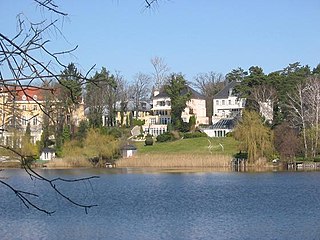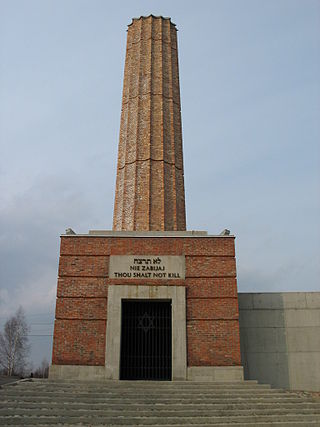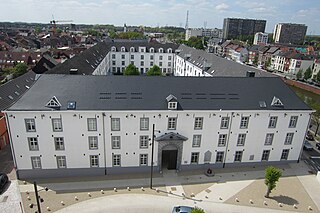
Wilmersdorf, an inner-city locality of Berlin, lies south-west of the central city. Formerly a borough by itself, Wilmersdorf became part of the new borough of Charlottenburg-Wilmersdorf in Berlin's 2001 administrative reform.

Drancy internment camp was an assembly and detention camp for confining Jews who were later deported to the extermination camps during the German occupation of France during World War II. Originally conceived and built as a modernist urban community under the name La Cité de la Muette, it was located in Drancy, a northeastern suburb of Paris, France.

Umschlagplatz was the term used during The Holocaust to denote the holding areas adjacent to railway stations in occupied Poland where Jews from ghettos were assembled for deportation to Nazi death camps. The largest collection point was in Warsaw next to the Warsaw Ghetto. In 1942 between 254,000 – 265,000 Jews passed through the Warsaw Umschlagplatz on their way to the Treblinka extermination camp during Operation Reinhard, the deadliest phase of the Holocaust in Poland. Often those awaiting the arrival of Holocaust trains, were held at the Umschlagplatz overnight. Other examples of Umschlagplatz include the one at Radogoszcz station - adjacent to the Łódź Ghetto - where people were sent to Chełmno extermination camp and Auschwitz.

Grunewald is a locality within the Berlin borough of Charlottenburg-Wilmersdorf. Until 2001 administrative reform it was part of the former district of Wilmersdorf.

Klosterstraße is a Berlin U-Bahn station located on the U2 in the centrally located Mitte district. The eponymous street is named after the Graues Kloster, a medieval Franciscan abbey, which later housed the Berlinisches Gymnasium zum Grauen Kloster.

Krumme Lanke, literally “Crooked Lake“, is a Berlin U-Bahn station on the U3. It is the line's southwestern terminus, located in the Zehlendorf district of Berlin.

Herzogenbusch was a Nazi concentration camp located in Vught near the city of 's-Hertogenbosch, Netherlands. The camp was opened in 1943 and held 31,000 prisoners. 749 prisoners died in the camp, and the others were transferred to other camps shortly before Herzogenbusch was liberated by the Allied Forces in 1944. After the war, the camp was used as a prison for Germans and for Dutch collaborators. Today there is a visitors' center which includes exhibitions and a memorial remembering the camp and its victims.

The Anhalter Bahnhof is a former railway terminus in Berlin, Germany, approximately 600 m (2,000 ft) southeast of Potsdamer Platz. Once one of Berlin's most important railway stations, it was severely damaged in World War II, and finally closed for traffic in 1952, when the GDR-owned Deutsche Reichsbahn rerouted all railway traffic between Berlin and places in the GDR avoiding the West Berlin area. The station's name lives on in the Berlin S-Bahn station of the same name, opened in October 1939 as part of the North-South S-Bahn link.

Radogoszcz station is a historic railway station in Łódź, Poland. The station, which was originally built between 1926 and 1937, was used extensively during The Holocaust. It served as the Umschlagplatz for transporting Jews from the Łódź Ghetto to the extermination camps during Operation Reinhard. The "loading platform" is in Marysin, a neighbourhood in the city's Bałuty district.

Holocaust trains were railway transports run by the Deutsche Reichsbahn and other European railways under the control of Nazi Germany and its allies, for the purpose of forcible deportation of the Jews, as well as other victims of the Holocaust, to the Nazi concentration, forced labour, and extermination camps.

The Mechelen transit camp, officially SS-Sammellager Mecheln in German, also known as the Dossin barracks, was a detention and deportation camp established in a former army barracks at Mechelen in German-occupied Belgium. It served as a point to gather Belgian Jews and Romani ahead of their deportation to concentration and extermination camps in Eastern Europe during the Holocaust.

Berlin Westkreuz is a station in the Charlottenburg district of Berlin. It is served by the S-Bahn lines S3, S41, S42, S46, S5, S7 and S9 and so represents a major interchange point on the Berlin S-Bahn network. It lies at the opposite end of the Stadtbahn to Ostkreuz and is one of the four main stations on the Ringbahn.

Heerstraße is a railway station in Berlin, Germany. It is located on the Spandau Suburban Line in the Westend district and served by S-Bahn S3 and S9 trains. The station is today listed as a historical monument.

Olympiastadion is a railway station in the Westend district of Berlin. Located at the southern entrance of the Olympic Stadium, it is served by the S-Bahn lines S3 and S9. The station consists of one island platform which is in regular use, as well as four further terminal island platforms which are only used for the extra trains during major events.

Poprad-Tatry railway station is a break-of-gauge junction station serving the city of Poprad, in the Prešov Region, northeastern Slovakia.

Pithiviers internment camp was a concentration camp in Vichy France, located 37 kilometres northeast of Orléans, closely associated with Beaune-la-Rolande internment camp in deporting foreign-born and some French-born Jews between 1941 and 1943 during WWII.

The Holocaust in Hungary was the dispossession, deportation, and systematic murder of more than half of the Hungarian Jews, primarily after the German occupation of Hungary in March 1944.

The Memoriale della Shoah is a Holocaust memorial at the Milano Centrale railway station commemorating the Jewish prisoners deported from there during the Holocaust in Italy. Jewish prisoners from the San Vittore Prison, Milan, were taken from there to a secret underground platform, Platform 21, to be loaded on freight cars and taken on Holocaust trains to extermination camps, either directly or via other transit camps. Twenty trains and up to 1,200 Jewish prisoners left Milan in this fashion to be murdered, predominantly at Auschwitz.






















